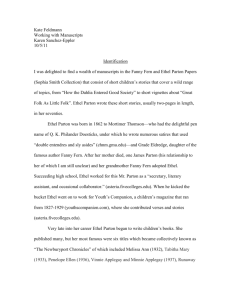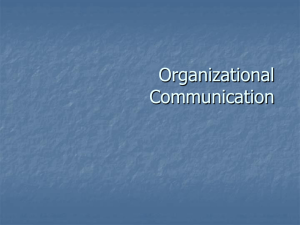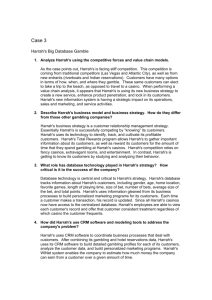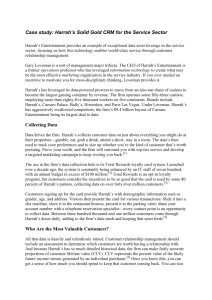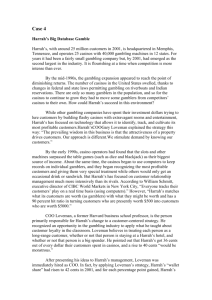File
advertisement
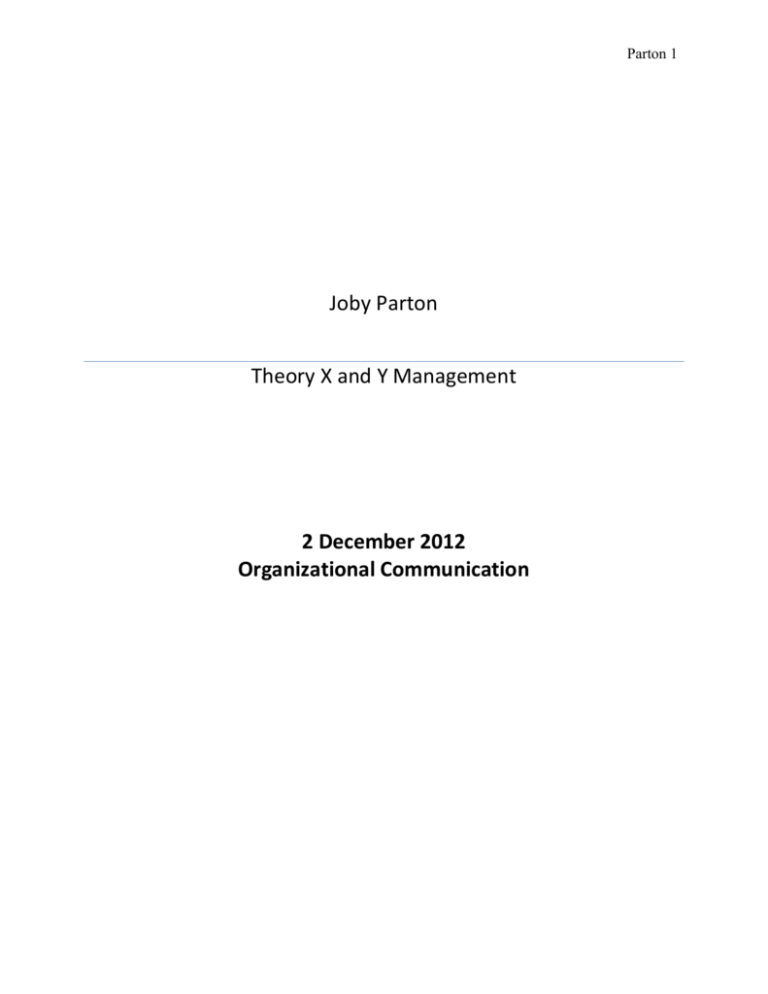
Parton 1 Joby Parton Theory X and Y Management 2 December 2012 Organizational Communication Parton 2 Joby Parton 2 December 2012 Research Paper Theory X and Theory Y, were created and developed by Douglas McGregor at the MIT Sloan School of Management in the 1960s. These theories relate to employee motivation and have been used in human resource management studies, organizational behavior analysis, and organizational development all across the world. They describe two very different attitudes towards workforce motivation. McGregor felt that companies followed either one of these approaches. According to our textbook, Organizational Communication, Alan Zaremba (2010) wrote, “Douglas McGregor suggested that there were essentially two ways managers looked at employees. He called these discrete perspectives Theory X and Theory Y,” (pg. 49). These are two very different ways of management to lead your team in the workplace, yet they both work in different situations considering the field of work and the employees. First, I am going to discuss Theory X. EmpTrack, a human resources website wrote of Theory X, “In this theory management assumes employees are inherently lazy and will avoid work if they can. Because of this, workers need to be closely supervised and comprehensive systems of control put in place. A hierarchical structure is needed, with narrow span of control at each level, for effective management. According to this theory employees will show little ambition without an enticing incentive program and will avoid responsibility whenever they can,” (2010). Overall, this theory assumes that employees only work for money and nothing more than that. They can do their tasks given to them and they will do nothing more on the job. Parton 3 In a real life example, when working at Harrahs, I have a manager names Stephanie Richardson. She is a fantastic manager in the sense that she micro-manages and she always brings revenue over the course of a year to the Buffet. She has done this job for many of years and is what most would call, “black and white.” Harrah’s main goal aside from making money is to keep their employees happy and to be relatable and lead their team, not manage it. Stephanie has issues with this because she believes that all employees are the same. She coaches all of her employees the same, in front of people and on the spot. Whereas, a good leadership manager would know their employees and coach them when it best suited the employee, not just the manager. When a server in her Buffet does something such as forgets to get a drink refill or does not greet a guest in an adequate amount of time according to Stephanie, then she immediately lashes out and scolds the employee visibly in front of customers in a tone based on her mood that day. This just has Theory X written all over it because she does not try to know the employee and feels the employee needs to be yelled at or they will not do the job effectively and efficiently. She thinks that people truly dislike work and need constant direction when doing the same task daily. She believes that all employees are inherently the same and that will never change. She has always been this type of manager, and unfortunately, everyone in our company knows that is the type of manager she will always be. She thinks workers need to be threatened and punishment to get better, yet in my experience working under her, this is very ineffective because I lost respect for her. Now in reference to this theory, Maslow’s hierarchy of needs is a huge necessity when understanding this part of the theory. Maslow believes that people have basic needs and they are on a pyramid. In the academic article, A Kind Word for Theory X: Or Why So Many Parton 4 Newfangled Management Techniques Quickly Fail, Micheal Bobic (2003) wrote, Maslow believed that human beings have five ascending types of needs that they seek to satisfy or fulfill within different environments. At the bottom of Maslow’s hierarchy of human needs are the basic physiological needs for food, shelter, and clothing. These needs must be “reasonably satisfied” before a person will turn his or her attention to the next higher order need, though “‘reasonable satisfaction’ is culturally defined. A subsistence level of satisfaction of physical needs in our society today is far higher than that, say, in the villages of India. Once physiological needs are met (and there is a certain assurance that they will continue to be met), a person turns his or her attention toward the need for safety from danger. McGregor’s observations about the work environment led him to conclude that most employees were not primarily concerned about either physiological or safety needs. The culture and structure of the workplace in the midtwentieth century generally seemed to satisfy such needs,” (pg. 242). Many people would argue that a majority of companies have Theory Y management tactics. This is for the most part accurate. This is my opinion is due to ethics and the standards set in place from the companies birth. In the article, The Influence of Theory X and Y Management Style on the Perception of Ethical Behavior in Organizations, James W. Neuliep wrote (1996), “Ironically, the Center for Business Ethics at Bentley College reports that 93% of Fortune 500 companies have written codes of ethics, 18% have ethics committees, and 8% have ethics training for employees. Indeed, in that same survey, 21% of the corporations indicated that they have made changes in their corporate structure to accommodate efforts to incorporate ethical values in their organization,” (pg. 1). This proves that most companies want Parton 5 to know their employees and that they want to create a stable and functional working environment. At Harrah’s we have to sign a code of ethics when we are hired stating all of the things our company stands for, including both co-workers and customers. We have to agree to greet all guests in a helpful manner and to treat all co-workers with respect. It also says that while you might not like everyone you work with, you must respect them and their beliefs while on Harrah’s watch. While I work in this environment, I encounter many different religions, beliefs and ethnicity groups. I always remember my code of ethics, especially as a manager because Harrah’s really thrives on these in our human resources department. In a way, they keep order and help leadership teams gear more towards a theory Y leadership approach. In the article, X-Theory Versus Management Discretion Theory, M. Crew writes (1971), “Profit maximization is retained as the central objective in the Theory X of the firm,” (pg. 176). This presumes to admit that companies who fall under the Theory X category tend to focus more on a profit and maximizing it as much as possible instead of getting to know their employees and having concern for their well-being. At Harrah’s, managers tend to know their employees so well that if they are having an off day they pull them in and ask them about it. Now this is a Theory Y management style example. Yet, if Harrah’s just chose to worry about profit alone, they would not have as many grateful and happy employees as they do. Our customers love our staff and the fact that we all greet them and always seem happy. This reflects a happy workplace and consequently customers are more likely to spend money because they are in a positive environment surrounded by happy people. In return, Harrah’s makes a profit, and I am sure that it is more Parton 6 than seven billion dollars annually. This is why Harrah’s is consistently voted one of the best places to work in the Kansas City area year after year. This is something we are very proud of and use to recruit new employees. Now let us discuss Theory Y management styles. . EmpTrack, a human resources website wrote of Theory Y, “Management influenced by this theory assumes that employees are ambitious, self-motivated, anxious to accept greater responsibility and exercise self-control, self-direction, autonomy and empowerment. Management believes that employees enjoy their work. They also believe that, given a chance, employees have the desire to be creative at their work place and become forward looking. There is a chance for greater productivity by giving employees the freedom to perform to the best of their abilities, without being bogged down by rules. A Theory Y manager believes that, given the right conditions, most people will want to do well at work and that there is a pool of unused creativity in the workforce. They believe that the satisfaction of doing a good job is a strong motivation in itself. A Theory Y manager will try to remove the barriers that prevent workers from fully actualizing themselves,” (2010). This is a more positive outlook on leadership styles and management in the workplace. Harrah’s is a fantastic example of how this theory is so right on the money. (No pun intended.) My manager, Scott Lokke, Vice President of Hospitality just reeks of Theory Y leadership. I say this with all respect and in the most positive light, I can. I look up to this man and the way he leads his team. He knows all of his employees and is consistently and views that people will work as natural as play in the right conditions. All management teams in his department work 45 plus hours a week, are ambitious, and prefer self-direction; Lokke recruits Parton 7 based on this trait for his leadership team. The first time I met this man, he told me that I had a lot of tenacity and then proceeded to ask if I thought that was a strength or weakness of mine. I proceeded to tell him it was a weakness because I am self-motivated and can direct myself if needed. This is the reason I got my internship, all because of this one answer that is Theory Y all the way. In an editorial I found titled, Theory Y, John E. Burns of DePaul University (1968) wrote, “This we see is a process primarily of creating opportunities, releasing potential, removing obstacles, encouraging growth, providing guidance. It is what Peter Drucker has called “management by objectives,” (pg. 1). Theory Y is the rebirth of the idea that if you create opportunities in the workplace for not only your employees, but also your management team then you will have tremendous growth in your company. My dad started his own small business in February of this year. Originally, he had realistic goals on revenue annually for the year and plans on hiring. Well as the year took off my father quickly figured out that he was going to need help. When going through the interview process he told me that he wanted someone new to the field that preferred guidance in the beginning and wanted this opportunity because they wanted to grow in this field. I found this odd because a new employee to the field meant more training. Yet, my dad said that way he could train them how he liked and he could instill positive qualities in the way he works. He also wanted someone who wanted to make this a career so that he could really guide them to be successful. I admired this in my father because he is always seeing the best in others and wants to help as many as he can. This Theory Y culture my dad is already beginning without knowing it Parton 8 creates proper conditions for ambitious young workers who are self-motivated. Eventually my dad’s company will be very profitable and successful because he is building a strong foundation from the ground up; beginning with himself. Another article I found helpful was, Theory Y Assumptions in a Non Theory Y World. Walter Nord (1978) stated, “Theory Y approaches have had some impact on how organizations are managed, it appears they have affected more what managers feel or say they do (or ought to do) than what they actually do,” (pg. 62). I believe this to mean that managers or leadership teams sometimes think they are acting in a positive style, when in all actuality they are not. Theory Y in this sense is stating that some managers say they are doing things that fall under the Theory Y category, however they are not; this is the wormhole in the system. Sometimes, saying you are doing something enough times makes you feel like you are actually doing it. It is ineffective if you are not doing it the correct way. That is where a great upper leadership team member comes into play. For example, when Stephanie sits in meetings on a Friday with our hospitality team she really believes that she is an effective manager and she falls as a Theory Y manager. However, Lokke is quick to say, “Look Steph, your tactics are not acceptable and you really should evaluate the way you lead your team in hectic situations. Some people don’t take criticism well when they are busy and on the fly.” Stephanie might get offended and say to his face that she will change, however, she will not. Old habits die hard and in this case of Theory Y management, not everyone can successful transition to it. Parton 9 Moving forward with Theory Y, High and Low Road Approaches to the Management of Human Resources: An Examination of the Relationship Between Business Strategy, Human Resource Management and High Performance Work Practices, written by Dr. Carol Gill and Dr. Denny Meyer of Melbourne University (2008) said, “Organisations and their managers need to believe that people are an important asset and are worthy of investment to successfully implement and derive benefit from these practices,” (pg. 106). These practices referring to Theory Y and the way human resources values their employees. Human resources departments are another huge aspect of why Theory Y can be successful within an organization. For instance, at Harrah’s human resources plays into every step of your employment with the company. They do checkpoints with all employees throughout the year to check progress and to ask about their overall experience as an employee. They even do exit surveys when a person moves on from the company, for whatever reason. This applies to Theory Y behavior because they are concerned about their employees and the innovation their insights could bring to the company. An employee’s physiological needs come first in the organization, followed by their safety needs, but human resources departments really want to know what your social needs experience is really like. What is the work culture in which you work in? How does it affect positively or negatively your performance? These are important questions to seek answers to because they can improve a department which in turn improves the organization in its entirety. Theory Y revolves around not only a leadership team that understands its employees, but also a workplace that is positive and helps a staff develop and become the best that they can be. Their growth process is the Parton 10 most important priority to a company; that is a rare quality, but an important one for this theory. In conclusion, Robert J. Graham said in the article, On the Death of Theory Y, that, “Motivation in an organization makes it difficult to create a Theory Y atmosphere,” (1980). I understand this because I have worked for organizations that in truth were managed terribly. Not all leadership teams are capable of having a successful Theory Y atmosphere. Take for instance generation X. They were raised to stay with the same company all their lives, work religiously, show up on time and be reliable. Nowhere in that were they taught true ethics, management by objective or even what Theory X and Theory Y are. They are the current managers of our workplace in most instances. Therefore, they manage the only way they know how and from their workplace experiences. As time moves forward and generation Y really takes over the workplace, I think the atmospheric change will be enormous. It is somewhat ironic, because generation X have Theory X management styles and generation Y have Theory Y styles. Yet another example; I work at the Elks Lodge in Maryville, Missouri. I love this job and everything that comes with it, most days. However, the crowd in that joint range from ages 2287 and this can cause controversy in management most days. I have no real defined boss. Technically, I am an employee of the lodge and therefore many can manage me. One of my bosses in particular name Mike Schreck is the most Theory X manager I have ever met in my life. This is hard for me because I am a true Theory Y manager and that is how I manage my employees. Therefore, it is hard being managed by someone who does not manage the way I believe is right. We have had a run in here recently and it brought me to tears because I was Parton 11 truly upset with the way he handled a situation verbally with me. I approached him about it and he told me, “I was the employee, he would treat me how he would like because he writes my check and he will say anything he would like even if I am working.” He was dead serious too and I was appalled at this. After sitting on this for about a month, I realized I learned a lot from this little insignificant encounter. Not every manger is going to manage the same. On the other side of the spectrum, most managers that are Theory X, are always going to be Theory X. Mike is never going to change because he believes that he is right and I am wrong. So who is to say that I am right or he is? Realistically it depends on the line of work you take part in. Mike came from factory line of work and never had an education in management. He is only acting the way he does because that is the only way he has ever been managed. I am Theory Y because of my experience and my education. These alone make a huge difference in my life and my career. More times than none in my line of work I am going to have to keep employees and their personalities in mind when coaching and disciplining; this is the world we live in. Mike is not wrong, and now I understand it more than ever. Theory X and Theory Y are more about your experiences and the generation you were raised in. While this might not always be true in every situation, it plays true to most. Theory X and Theory Y both have their negatives and positives. They both work effectively based on where applied and to what employee they are applied too. In my experiences and most worldly modern experiences Theory Y is more predominate and in time will be the only management style used to govern the workplace. Parton 12 Bibliography Bobic, M. P., & Davis, W. (2003). A Kind Word for Theory X: Or Why So Many Newfangled Management Techniques Quickly Fail. Journal Of Public Administration Research And Theory, 13(3), 239-264. Burns, J. E. (1968). THEORY Y. Industrial Management, 10(2), 1. Crew, M. A., Jones-Lee, M. W., & Rowley, C. K. (1971). X-THEORY VERSUS MANAGEMENT DISCRETION THEORY. Southern Economic Journal, 38(2), 173. EmpTrack. (2010, January). Theory x and theory y: Theories of employee motivation. http://www.empxtrack.com/resources/hr-articles/theory-x-and-theory-y-theories-ofemployee-motivation/ Gill, C., & Meyer, D. (2008). HIGH AND LOW ROAD APPROACHES TO THE MANAGEMENT OF HUMAN RESOURCES: AN EXAMINATION OF THE RELATIONSHIP BETWEEN BUSINESS STRATEGY, HUMAN RESOURCE MANAGEMENT AND HIGH PERFORMANCE WORK PRACTICES. International Journal Of Employment Studies, 16(2), 67-112. Graham, R. J. (1980). On The Death of Theory Y. Interfaces, 10(3), 76-79. Neuliep, J. W. (1996). The Influence of Theory X and Y Management Style on the Perception of Ethical Behavior in Organizations. Journal Of Social Behavior & Personality, 11(2), 301311. Parton 13 Neuliep, J. W. (1987). THE INFLUENCE OF THEORY X AND THEORY Y MANAGEMENT STYLES ON THE SELECTION OF COMPLIANCE-GAINING STRATEGIES. Communication Research Reports, 4(1), 14-19. Wynne, B., & Nord, W. (1978). THEORY Y ASSUMPTIONS IN A NON-THEORY Y WORLD. Interfaces, 8(2), 61-66. Zaremba, A. (2010). Organizational communication. (3rd ed., pp. 50-54). Oxford New York: Oxford University Press.




